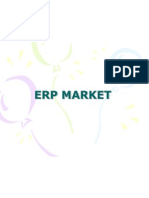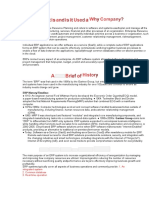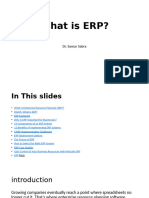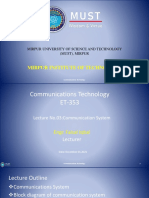C S 2
C S 2
Uploaded by
Bharat ShahCopyright:
Available Formats
C S 2
C S 2
Uploaded by
Bharat ShahOriginal Title
Copyright
Available Formats
Share this document
Did you find this document useful?
Is this content inappropriate?
Copyright:
Available Formats
C S 2
C S 2
Uploaded by
Bharat ShahCopyright:
Available Formats
08/IT/53
PRACTICAL: 2 AIM: case study: Introduction to ERP and SAP R/3.
Introduction:
ERP is software driven business management system that helps to integrate all functions of a business including planning, manufacturing sales and marketing.ERP aimed at helping the manufacturing for setting better business practices and equipping them with correct info for taking timely decisions.ERP initially targeted the manufacturing industry and deal with functions such as planning and managing businesses like sales management, production management, accounting finances. SAP is the world's largest enterprise software company and the world's third-largest independent software supplier overall. R/3 is scalable and highly suited for many types and sizes of organizations. SAP R/3 runs on several databases Oracle, ADABAS D, Informix, DB2 for UNIX, DB2/400, Microsoft's SQL Server 6.0. ERP consists of common global processes and systems integrated across all business units. With SAP R/3, all units like Manufacturing, Order Management, and Product Delivery are linked together across business units with greater speed, accuracy, and service to the customers with utmost satisfaction. A key outcome from SAP R/3 implementation will be more robust processes which in turn increase the Operating Excellence and also help in facilitating easier integration of new businesses and acquisitions. A sample like SAP R/3 process helps in generating invoices that are easier to read and understand.
SAP R/3 integrates many application and some to name are:
Financial applications Distribution applications Human resources applications Manufacturing applications Indeed, so broad is SAP R/3 that it offers virtually every common business application needed by a typical enterprise. SAP R/3's applications are modules. They can be used either alone or combined with other solutions. The integration capability of these applications increases the benefits derived for any company. Some of them are namely: Materials Management: MM optimizes all purchasing processes, helps in accurate inventory and warehouse management and so on. Production Planning and Control: This helps in the management of all process and all types of manufacturing like assemble-to-order production, supply chain management and so on.
08/IT/53
Sales & Distribution: This helps in all sales and distribution activities namely pricing, on-time delivery, profitability analysis and so on. Financial Accounting: This module helps in gathering all accounting information and documenting and thereby helps in producing a report and information that can be used for analysis and control and planning. Controlling: This helps in the control of complete controlling system, internal process of company and so on. Payroll Accounting: This helps in centralizing the payroll process and helps in giving a global view and maintaining the data securely. Organizational Management: This helps in giving an accurate picture of organization structure and also helps in cost planning even in the individual level.
Characteristics:
Packaged software Integrate the majority of businesss processes Use a data warehouse Allow access to data in real time
Modularity:
Most systems are modular to permit automating some functions but not others. Some common modules, such as finance and accounting, are adopted by nearly all users; others such as human resource management are not. For example, a service company probably has no need for a manufacturing module. Other companies already have a system that they believe to be adequate. Generally speaking, the greater the number of modules selected, the greater the integration benefits, but also the greater the costs, risks and changes involved.
Advantages:
ERP allows easier global integration. ERP provides real time information, reducing the possibility of redundancy errors. ERP may create a more efficient work environment for employee. SAPs R/3 is very versatile as, it will operate on six different platforms. SAPs R/3 is available in 14 different languages. SAPs R/3 provides for a single data entry point where the data entered from any location is instantly sent to all other appropriate modules in the ERP system.
08/IT/53
Disadvantages:
Customization is problematic. ERP can cost more than less integrated and/or less comprehensive solution. High switching cost increase vendor negotiating power. Extensive training requirement takes resources from daily dependencies.
Company Name: Barden Corporation
Barden is a part of the German FAG Kugelfiscergroup and make high precision bearings for applications such as high precision machine tool spindles, aerospace and other very demanding applications. Barden had just implemented the SAP R/3, during the first week of October 1998. R/3 is the market leading Enterprise Resource Planning (ERP) software from the German company SAP. Following the implementation course, Barden draw up an education programme to achieve the necessary level of understanding. The project then became the implementation of a new and better way to plan the business using the software as the tool rather than just the implementation of new software. In the first phase of education, 30 people out of a total payroll of 250 attended one or more of our courses. A significant factor in this successful implementation was that Barden did more than the minimum education on both the Business Excellence principles as well as the SAP R/3 software. The revised, more realistic, time scale was another significant factor in their successful implementation. R/3 would convert to the customer and supplier numbers at the system boundaries. Another nice feature of SAP R/3 is that it was able to maintain the old part number in a different field. Once they had implemented SAP, they could use the standard SAP report on the reduced number of suppliers. Transferring data into a package as complex as SAP R/3 is never easy or quick. Barden now have bills of material and routings over 99% accurate. This was a key factor in getting everyone using the common database at all level within the business, a key component of Business Excellence. The ease of use of SAP R/3 was a factor here.
08/IT/53
You might also like
- C TS412 2021-DemoDocument5 pagesC TS412 2021-DemoDanielpremassisNo ratings yet
- MM Project ReportDocument124 pagesMM Project Reportsiva63% (8)
- History of ERPDocument8 pagesHistory of ERPK aeriNo ratings yet
- Sap Abap Material Learning From Ground UpDocument211 pagesSap Abap Material Learning From Ground UpRaj Kumar Tiwari100% (9)
- SAP R/3 Fundamentals: Unit 1: Introducing The R/3 SystemDocument8 pagesSAP R/3 Fundamentals: Unit 1: Introducing The R/3 SystembogasrinuNo ratings yet
- Enterprise Resource Planning (Erp) the Great Gamble: An Executive’S Guide to Understanding an Erp ProjectFrom EverandEnterprise Resource Planning (Erp) the Great Gamble: An Executive’S Guide to Understanding an Erp ProjectRating: 4.5 out of 5 stars4.5/5 (5)
- Updated ABAP Material DocumentDocument213 pagesUpdated ABAP Material DocumentKishore ReddyNo ratings yet
- Erp MarketDocument35 pagesErp Marketsakshi guptaNo ratings yet
- Produkte, German For "Systems Applications and Products." TheDocument5 pagesProdukte, German For "Systems Applications and Products." ThegauravetoorNo ratings yet
- Sap FicoDocument210 pagesSap Ficoasrinu88881125100% (1)
- Introduction of The ProjectDocument45 pagesIntroduction of The ProjectAnil Kumar T GNo ratings yet
- Erp MarketDocument35 pagesErp MarketSubash Sharma100% (1)
- Enterprise Resource PlanningDocument10 pagesEnterprise Resource PlanningAvisekh KumarNo ratings yet
- Industrial Training Report On SAPDocument34 pagesIndustrial Training Report On SAPPrakhar Bhatnagar100% (1)
- A UNIT 2 ERP NOTESDocument22 pagesA UNIT 2 ERP NOTESluckymanvelloreNo ratings yet
- Enterprise Resource Planning: Assignment 1 Shubhi Srivastava BFT-6Document9 pagesEnterprise Resource Planning: Assignment 1 Shubhi Srivastava BFT-6Himanshu ShekharNo ratings yet
- Benefits of Using SAP For Your Business PDFDocument4 pagesBenefits of Using SAP For Your Business PDFbiltexNo ratings yet
- Erp SapDocument3 pagesErp Sapsujeet kumarNo ratings yet
- SAP FI - General LedgerDocument154 pagesSAP FI - General LedgersekhardattaNo ratings yet
- C Enterprise Resource PlanningerpDocument11 pagesC Enterprise Resource Planningerpchittesh23100% (1)
- Foundations For Understanding ERP Systems: Enterprise Resource PlanningDocument9 pagesFoundations For Understanding ERP Systems: Enterprise Resource PlanningFitha FathimaNo ratings yet
- Assignemnt No. 3 Syed Hassan Ahmed Naqvi 20121-14135 ERPDocument4 pagesAssignemnt No. 3 Syed Hassan Ahmed Naqvi 20121-14135 ERPHassan AhmedNo ratings yet
- 91,500 28,000 12 Million 120 Countries."Document3 pages91,500 28,000 12 Million 120 Countries."Naveen LohchabNo ratings yet
- SAP HistoryDocument2 pagesSAP HistoryTonyNo ratings yet
- R E S O U R C E S: Resource Management SoftwareDocument16 pagesR E S O U R C E S: Resource Management SoftwareDhruv GuptaNo ratings yet
- Ass 3 It Elective 3Document2 pagesAss 3 It Elective 3kiteNo ratings yet
- Lab Sessions: Management Information SystemsDocument8 pagesLab Sessions: Management Information SystemsHarsh ChaudhryNo ratings yet
- Unit 4 ERP Tools / Software and Selection Methodology: StructureDocument24 pagesUnit 4 ERP Tools / Software and Selection Methodology: StructureAnonymous bTh744z7E6No ratings yet
- Module1 ERP & SAP IntroductionDocument13 pagesModule1 ERP & SAP Introductionsarkar.parthasarathiNo ratings yet
- Module 1 PrE8Document7 pagesModule 1 PrE8princessmalit2003No ratings yet
- SAP Basic Setting Module1Document27 pagesSAP Basic Setting Module1SHubhamNo ratings yet
- Enterprise ResourceDocument5 pagesEnterprise ResourceHuma ShafiqueNo ratings yet
- What Is SAP R3Document10 pagesWhat Is SAP R3madhukar_reddy_4No ratings yet
- SAP All Slides in DetailDocument21 pagesSAP All Slides in DetailAbdelhamid HarakatNo ratings yet
- Here Are Some of Generic ERP Capabilities That Can Be Used in The Manufacturing SectorDocument11 pagesHere Are Some of Generic ERP Capabilities That Can Be Used in The Manufacturing SectorAnonymous sMqylHNo ratings yet
- Enterprise Resource Planning: BATCH: 2009-2013Document27 pagesEnterprise Resource Planning: BATCH: 2009-2013Anand Singh100% (1)
- Enterprise Resource Planning (Erp) : Presented by GROUP 1Document21 pagesEnterprise Resource Planning (Erp) : Presented by GROUP 12ndyearacc05No ratings yet
- Enterprise Resource Planning (ERP)Document10 pagesEnterprise Resource Planning (ERP)Bhushan BariNo ratings yet
- What Is ERP Unit 1-1Document4 pagesWhat Is ERP Unit 1-1BWUBCA19 061No ratings yet
- Project ReportDocument27 pagesProject ReportBharti RaiNo ratings yet
- My SapDocument83 pagesMy SapPraveen KumarNo ratings yet
- The Concept of ERPDocument34 pagesThe Concept of ERPdr. samar SabraNo ratings yet
- Enterprise Resource PlanningDocument6 pagesEnterprise Resource PlanningKAUSHIK SUNDARARAJANNo ratings yet
- Advantages of ErpDocument11 pagesAdvantages of ErpYogesh BachchaniNo ratings yet
- 1.1.5_Enterprise Resource Planning_20220817_090509Document25 pages1.1.5_Enterprise Resource Planning_20220817_090509PUNE DIVISIONNo ratings yet
- MIS Assignment 1Document6 pagesMIS Assignment 1Muhammad Qasim RazaNo ratings yet
- What Is ERP SystemDocument8 pagesWhat Is ERP Systemzillurr_11100% (1)
- FI Material 2 NEWDocument569 pagesFI Material 2 NEWPrathamesh Parker100% (9)
- Chapter 1 - ERPDocument56 pagesChapter 1 - ERPDiamond SmithNo ratings yet
- SAP Business Model and StrategiesDocument3 pagesSAP Business Model and StrategiesAladinAh100% (2)
- Emre Tezcan MBA 631 Awa 4Document6 pagesEmre Tezcan MBA 631 Awa 4emretez86No ratings yet
- Mysap Fi Fieldbook: Fi Fieldbuch Auf Der Systeme Anwendungen Und Produkte in Der DatenverarbeitungFrom EverandMysap Fi Fieldbook: Fi Fieldbuch Auf Der Systeme Anwendungen Und Produkte in Der DatenverarbeitungRating: 4 out of 5 stars4/5 (1)
- A Handbook on Various Aspects of Business and Its Integration with Finance in Modern World: A Bridgeway to Thoughtful CommunicationFrom EverandA Handbook on Various Aspects of Business and Its Integration with Finance in Modern World: A Bridgeway to Thoughtful CommunicationNo ratings yet
- Book Series Increasing Productivity of Software Development, Part 2: Management Model, Cost Estimation and KPI ImprovementFrom EverandBook Series Increasing Productivity of Software Development, Part 2: Management Model, Cost Estimation and KPI ImprovementNo ratings yet
- Robotic Process Automation (RPA) in the Financial Sector: Technology - Implementation - Success For Decision Makers and UsersFrom EverandRobotic Process Automation (RPA) in the Financial Sector: Technology - Implementation - Success For Decision Makers and UsersNo ratings yet
- Application and Technology Rationalization: A Strategic Guide for Midsize to Large Companies: IT and Digital TransformationFrom EverandApplication and Technology Rationalization: A Strategic Guide for Midsize to Large Companies: IT and Digital TransformationNo ratings yet
- Codeacademy - Afterschool Kit PDFDocument37 pagesCodeacademy - Afterschool Kit PDFAnca Secăreanu100% (1)
- PCU20 Series StartupDocument6 pagesPCU20 Series StartupSam eagle goodNo ratings yet
- Sinap New Data SheetDocument4 pagesSinap New Data SheetmynksharmaNo ratings yet
- User Guide FTB-8510Document206 pagesUser Guide FTB-8510Anonymous d0J9xGuLZoNo ratings yet
- VLA 27 0.secured - LabDocument144 pagesVLA 27 0.secured - Lablorenabsouza0911No ratings yet
- Research Paper Final 1Document5 pagesResearch Paper Final 1Raaj SinghNo ratings yet
- Raw Data Karyawan DashboardDocument15 pagesRaw Data Karyawan DashboardRezaHardiansyahNo ratings yet
- OoadDocument10 pagesOoadRaphael MuriithiNo ratings yet
- Using G To Control An Instrument (Ver VISA)Document16 pagesUsing G To Control An Instrument (Ver VISA)NeneFINo ratings yet
- Power Bi SuccinctlyDocument146 pagesPower Bi Succinctlyddoru100% (1)
- Keygen (Clé D'activation) : Logiciels - HTMLDocument5 pagesKeygen (Clé D'activation) : Logiciels - HTMLDixi Aguilar100% (1)
- Chinese Innioasis g1 mp3 Player ManualDocument9 pagesChinese Innioasis g1 mp3 Player ManualkcarringNo ratings yet
- ELL815 MIMO Wireless Communications Course HandoutDocument2 pagesELL815 MIMO Wireless Communications Course HandoutKeshav AwasthiNo ratings yet
- Siemens SW Twelve Ways VeSys Makes Wiring and Harness Design Faster and Better White Paper - tcm27-89537Document6 pagesSiemens SW Twelve Ways VeSys Makes Wiring and Harness Design Faster and Better White Paper - tcm27-89537Jeroen van den BroekeNo ratings yet
- Question Set 1Document2 pagesQuestion Set 1anshikaNo ratings yet
- DATA BASE MANAGEMENT SYSTEMS Oct-Nov 2019Document4 pagesDATA BASE MANAGEMENT SYSTEMS Oct-Nov 2019Vaddimukkala Sri Sai CharithaNo ratings yet
- Collar2 User Manual v4Document2 pagesCollar2 User Manual v4Ripan RoyNo ratings yet
- ET-353, Lecture 03 (Communication System)Document34 pagesET-353, Lecture 03 (Communication System)Jahanzaib MushtaqNo ratings yet
- Technical Specification Document TemplateDocument23 pagesTechnical Specification Document TemplateXuân TuấnNo ratings yet
- 802.11ax - Performance Comparison of Wireless Protocol IEEE 802.11ax Vs 802.11acDocument5 pages802.11ax - Performance Comparison of Wireless Protocol IEEE 802.11ax Vs 802.11acvianardiyansyah.sNo ratings yet
- PLSQLDocument7 pagesPLSQLRajneesh KumarNo ratings yet
- Python From ScratchDocument8 pagesPython From ScratchAkashRaiNo ratings yet
- DIALux Setup LogDocument156 pagesDIALux Setup LogPetherson Jesus BatistaNo ratings yet
- Python - Basic - 2 - Jupyter Notebook (Student)Document34 pagesPython - Basic - 2 - Jupyter Notebook (Student)Mesbahur RahmanNo ratings yet
- UT Dallas Syllabus For Cs6385.0i1 05f Taught by Andras Farago (Farago)Document2 pagesUT Dallas Syllabus For Cs6385.0i1 05f Taught by Andras Farago (Farago)UT Dallas Provost's Technology GroupNo ratings yet
- Classification Tree MethodDocument5 pagesClassification Tree Methoddarksoul3232No ratings yet
- Coco SimulatorDocument2 pagesCoco SimulatorMary FlorNo ratings yet
- Handbook FibeAir IP 20G Basic Training Course 7 7 Ver2Document178 pagesHandbook FibeAir IP 20G Basic Training Course 7 7 Ver2santiago30101987No ratings yet
























































































